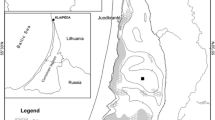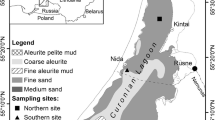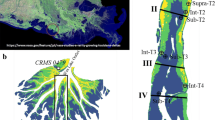Abstract
Harmful blooms of cyanobacteria may extend over long time spans due to self-sustaining mechanisms. We hypothesized that settled blooms may increase redox-dependent P release and unbalance the stoichiometry of benthic nutrient regeneration (NH4+:SiO2:PO43− ratios). We tested this hypothesis in the hypertrophic Curonian Lagoon, the largest in Europe. During summer, at peak chlorophyll and water temperatures, sediment cores were collected over 19 stations representing all the lagoon sedimentary environments. Sediment organic content, granulometry, aerobic respiration, and oxic and anoxic fluxes of dissolved inorganic nutrients and metals—Fe2+ and Mn2+—were measured. Loads and stoichiometry of regenerated nutrients were compared with those from the watershed. Analyzed sediments had elevated oxygen demand (−1.90 to −5.66 mmol O2 m−2 h−1), generally uncoupled to their variable organic matter content (1–23%) and median particle size (30–300 μm). Under oxic conditions, summer internal recycling equaled (SiO2) or exceeded, by a factor of ~66 and ~ 2, external loads of NH4+ and PO43−, respectively. Transient anoxia produced a general decrease of NH4+ and SiO2 regeneration, likely due to decreased macrofauna activity or inefficient mineralization, whereas it doubled average PO43− fluxes. In sandy, well-flushed areas, anoxia had a minor effect on PO43−, but stimulated a large production of Mn2+. Muddy sediments in lagoon areas with slow water renewal displayed large redox-dependent PO43− mobility, coupled to Fe2+ release. Settled algal blooms and hypoxic conditions might unbalance benthic regeneration stoichiometry and sustain blooms. The sedimentary pool of Mn4+ may represent a natural buffer preventing iron reduction and PO43− mobility.





Similar content being viewed by others
References
Abril, G., H. Etcheber, P. Le Hir, P. Bassoullet, B. Boutier, and M. Frankignoulle. 1999. Oxic/anoxic oscillations and organic carbon mineralization in an estuarine maximum turbidity zone (the Gironde, France). Limnology and Oceanography 44 (5): 1304–1315. https://doi.org/10.4319/lo.1999.44.5.1304.
Aller, R.C. 1994. The sedimentary Mn cycle in Long Island Sound: Its role as intermediate oxidant and the influence of bioturbation, O2, and Corg flux on diagenetic reaction balances. Journal of Marine Research 52 (2): 259–295.
Anschutz, P., S. Bouchet, G. Abril, R. Bridou, E. Tessier, and D. Amouroux. 2019. In vitro simulation of oscillatory redox conditions in intertidal sediments: N, Mn, Fe, and P coupling. Continental Shelf Research 177: 33–41. https://doi.org/10.1016/j.csr.2019.03.007.
Azzoni, R., G. Giordani, and P. Viaroli. 2005. Iron–sulphur–phosphorus interactions: Implications for sediment buffering capacity in a mediterranean eutrophic lagoon (Sacca di Goro, Italy). Hydrobiologia 550 (1): 131–148. https://doi.org/10.1007/s10750-005-4369-x.
Bartoli, M., D. Longhi, D. Nizzoli, S. Como, P. Magni, and P. Viaroli. 2009. Short term effects of hypoxia and bioturbation on solute fluxes, denitrification and buffering capacity in a shallow dystrophic pond. Journal of Experimental Marine Biology and Ecology 381 (2): 105–113. https://doi.org/10.1016/j.jembe.2009.09.018.
Bartoli, M., M. Zilius, M. Bresciani, D. Vaiciute, I. Vybernaite-Lubiene, J. Petkuviene, G. Giordani, D. Daunys, T. Ruginis, S. Benelli, C. Giardino, P.A. Bukaveckas, P. Zemlys, E. Griniene, Z.R. Gasiunaite, J. Lesutiene, R. Pilkaitytė, and A. Baziukas-Razinkovas. 2018. Drivers of cyanobacterial blooms in a hypertrophic lagoon. Frontiers in Marine Science 5: 434. https://doi.org/10.3389/fmars.2018.00434.
Benelli, S., M. Bartoli, M. Zilius, I. Vybernaite-Lubiene, T. Ruginis, J. Petkuviene, and E.A. Fano. 2018. Microphytobenthos and chironomid larvae attenuate nutrient recycling in shallow-water sediments. Freshwater Biology 63 (2): 187–201. https://doi.org/10.1111/fwb.13052.
Benelli, S., M. Bartoli, M. Zilius, I. Vybernaite-Lubiene, T. Ruginis, D. Vaiciute, J. Petkuviene, and E.A. Fano. 2019. Stoichiometry of regenerated nutrients differs between native and invasive freshwater mussels with implications for algal growth. Freshwater Biology 64 (4): 619–631. https://doi.org/10.1111/fwb.13247.
Bernot, M.J., and W.K. Dodds. 2005. Nitrogen retention, removal, and saturation in lotic ecosystems. Ecosystems 8 (4): 442–453. https://doi.org/10.1007/s10021-003-0143-y.
Bower, C.E., and T. Holm-Hansen. 1980. A salicylate–hypochlorite method for determining ammonia in seawater. Canadian Journal of Fisheries and Aquatic Sciences 37 (5): 794–798. https://doi.org/10.1139/f80-106.
Bresciani, M., C. Giardino, D. Stroppiana, R. Pilkaitytė, M. Bartoli, and A. Razinkovas. 2012. Retrospective analysis of spatial and temporal variability of chlorophyll-a in the Curonian Lagoon. Journal of Coastal Conservation 16 (4): 511–519. https://doi.org/10.1007/s11852-012-0192-5.
Bresciani, M., M. Adamo, G. De Carolis, E. Matta, G. Pasquariello, D. Vaičiūtė, and C. Giardino. 2014. Monitoring blooms and surface accumulation of cyanobacteria in the Curonian Lagoon by combining MERIS and ASAR data. Remote Sensing of Environment 146: 124–135. https://doi.org/10.1016/j.rse.2013.07.040.
Canfield, D.E., B. Thamdrup, and J.W. Hansen. 1993. The anaerobic degradation of organic matter in Danish coastal sediments: Iron reduction, manganese reduction, and sulfate reduction. Geochimica et Cosmochimica Acta 57 (16): 3867–3883.
Canfield, D.E. 1994. Factors influencing organic carbon preservation in marine sediments. Chemical Geology 114 (3-4): 315–329.
Canfield, D., E. Kristensen, and B. Thamdrup. 2005. Aquatic geomicrobiology. New York: Academic Press.
Conley, D.J., M.A. Quigley, and C.L. Schelske. 1988. Silica and phosphorus flux from sediments: Importance of internal recycling in Lake Michigan. Canadian Journal of Fisheries and Aquatic Sciences 45 (6): 1030–1035. https://doi.org/10.1139/f88-126.
de Vicente, I., V. Amores, F. Guerrero, and L. Cruz-Pizarro. 2010. Contrasting factors controlling microbial respiratory activity in the sediment of two adjacent Mediterranean wetlands. Naturwissenschaften 97 (7): 627–635. https://doi.org/10.1007/s00114-010-0678-7.
Ding, S., M. Chen, M. Gong, X. Fan, B. Qin, H. Xu, S. Gao, Z. Jin, D.C.W. Tsang, and C. Zhang. 2018. Internal phosphorus loading from sediments causes seasonal nitrogen limitation for harmful algal blooms. Science of the Total Environment 625: 872–884. https://doi.org/10.1016/j.scitotenv.2017.12.348.
Dixit, S., and P. Van Cappellen. 2002. Surface chemistry and reactivity of biogenic silica. Geochimica et Cosmochimica Acta 66 (14): 2559–2568. https://doi.org/10.1016/S0016-7037(02)00854-2.
Ferrarin, C., A. Razinkovas, S. Gulbinskas, G. Umgiesser, and L. Bliūdžiutė. 2008. Hydraulic regime-based zonation scheme of the Curonian Lagoon. Hydrobiologia 611 (1): 133–146. https://doi.org/10.1007/s10750-008-9454-5.
Friedl, G., C. Dinkel, and B. Wehrli. 1998. Benthic fluxes of nutrients in the northwestern Black Sea. Marine Chemistry 62 (1-2): 77–88. https://doi.org/10.1016/S0304-4203(98)00029-2.
Galloway, J. N., A. R. Townsend, J. W. Erisman, M. Bekunda, , Z. Cai, J. R. Freney, L. A. Martinelli, S. P. Seitzinger, M. A. Sutton 2008. Transformation of the nitrogen cycle: Recent trends, questions, and potential solutions. Science 320: 889–892. doi: https://doi.org/10.1126/science.1136674, 5878.
Gasiūnaitė, Z. R., D. Daunys, S. Olenin, and A. Razinkovas. 2008. The Curonian Lagoon. In Ecology of Baltic Coastal Waters, ed. U. Schiewer. Berlin: Springer Heidelberg.
Ghaisas, N.A., K. Maiti, and J.R. White. 2019. Coupled iron and phosphorus release from seasonally hypoxic Louisiana shelf sediment. Estuarine, Coastal and Shelf Science 219: 81–89. https://doi.org/10.1016/j.ecss.2019.01.019.
Giordani, G., M. Bartoli, M. Cattadori, and P. Viaroli. 1996. Sulphide release from anoxic sediments in relation to iron availability and organic matter recalcitrance and its effects on inorganic phosphorus recycling. In Eutrophication and ANaerobic Processes (CLEAN), ed. Coastal Lagoon, 211–222. Dordrecht: Springer.
Glibert, P.M. 2012. Ecological stoichiometry and its implications for aquatic ecosystem sustainability. Current Opinion in Environmental Sustainability 4 (3): 272–277. https://doi.org/10.1016/j.cosust.2012.05.009.
Glud, R.N. 2008. Oxygen dynamics of marine sediments. Marine Biology Research 4 (4): 243–289. https://doi.org/10.1080/17451000801888726.
Grasshoff, K., K. Kremling, and M. Ehrhardt. 1983. Methods of seawater analysis. In 2nd eds. Berlin Chemie: Verlag.
Han, H., and J.D. Allan. 2012. Uneven rise in N inputs to the Lake Michigan Basin over the 20th century corresponds to agricultural and societal transitions. Biogeochemistry 109 (1-3): 175–187. https://doi.org/10.1007/s10533-011-9618-7.
Humborg, C., D.J. Conley, L. Rahm, F. Wulff, A. Cociasu, and V. Ittekkot. 2000. Silicon retention in river basins: Far-reaching effects on biogeochemistry and aquatic food webs in coastal marine environments. Ambio: A Journal of the Human Environment 29 (1): 45–50. https://doi.org/10.1579/0044-7447-29.1.45.
Kruopiene, J. 2007. Distribution of heavy metals in sediments of the Nemunas River (Lithuania). Polish Journal of Environmental Studies 16: 715–722.
Middelburg, J.J., and L.A. Levin. 2009. Coastal hypoxia and sediment biogeochemistry. Biogeosciences Discussions 6 (2): 3655–3706.
Muhlolland, P.J., A.M. Helton, G.C. Poole, R.O. Hall, S.K. Hamilton, B.J. Peterson, J.L. Tank, et al. 2008. Stream denitrification across biomes and its response to anthropogenic nitrate loading. Nature 452 (7184): 203–205. https://doi.org/10.1038/nature06686.
Nausch, M., G. Nausch, and N. Wasmund. 2004. Phosphorus dynamics during the transition from nitrogen to phosphate limitation in the Central Baltic Sea. Marine Ecology Progress Series 266: 15–25. https://doi.org/10.3354/meps266015.
Neubacher, E.C., R.E. Parker, and M. Trimmer. 2011. Short-term hypoxia alters the balance of the nitrogen cycle in coastal sediments. Limnology and Oceanography 56 (2): 651–665. https://doi.org/10.4319/lo.2011.56.2.0651.
Nixon, S.W. 1995. Coastal marine eutrophication: A definition, social causes, and future concerns. Ophelia 41 (1): 199–219. https://doi.org/10.1080/00785236.1995.10422044.
Norkko, A., and E. Bonsdorff. 1996. Population responses of coastal zoobenthos to stress induced by drifting algal mats. Marine Ecology and Progress Series 140: 141–151.
Paerl, H.W. 2009. Controlling eutrophication along the freshwater-marine continuum: Dual nutrient (N and P) reductions are essential. Estuaries and Coasts 32 (4): 593–601. https://doi.org/10.1007/s12237-009-9158-8.
Paerl, H.W., and J.T. Scott. 2010. Throwing fuel on the fire: Synergistic effects of excessive nitrogen inputs and global warming on harmful algal blooms. Environmental Science & Technology 44 (20): 7756–7758. https://doi.org/10.1021/es102665e.
Paerl, H.W., N.S. Hall, and E.S. Calandrino. 2011. Controlling harmful cyanobacterial blooms in a world experiencing anthropogenic and climatic-induced change. Science of the Total Environment 409 (10): 1739–1745. https://doi.org/10.1016/j.scitotenv.2011.02.001.
Pakhomova, S.V., P.O. Hall, M.Y. Kononets, A.G. Rozanov, A. Tengberg, and A.V. Vershinin. 2007. Fluxes of iron and manganese across the sediment–water interface under various redox conditions. Marine Chemistry 107 (3): 319–331. https://doi.org/10.1016/j.marchem.2007.06.001.
Petkuviene, J., M. Zilius, I. Lubiene, T. Ruginis, G. Giordani, A. Razinkovas-Baziukas, and M. Bartoli. 2016. Phosphorus cycling in a freshwater estuary impacted by cyanobacterial blooms. Estuaries and Coasts 39 (5): 1386–1402. https://doi.org/10.1007/s12237-016-0078-0.
Pimenov, N.V., M.O. Ul’yanova, T.A. Kanapatskii, I.N. Mitskevich, I.I. Rusanov, P.A. Sigalevich, I.A. Nemirovskaya, and V.V. Sivkov. 2013. Sulfate reduction, methanogenesis, and methane oxidation in the upper sediments of the Vistula and Curonian Lagoons, Baltic Sea. Microbiology 82 (2): 224–233. https://doi.org/10.1134/S0026261713020136.
Pusceddu, A., A. Dell’Anno, M. Fabiano, and R. Danovaro. 2009. Quantity and bioavailability of sediment organic matter as signatures of benthic trophic status. Marine Ecology Progress Series 375: 41–52. https://doi.org/10.3354/meps07735.
Redfield, A.C. 1958. The biological control of chemical factors in the environment. American Scientist 46: 205–221.
Relexans, J.C., H. Etcheber, J. Castel, V. Escaravage, and I. Auby. 1992. Benthic respiratory potential with relation to sedimentary carbon quality in seagrass beds and oyster parks in the tidal flats of Arcachon Bay, France. Estuarine, Coastal and Shelf Science 34 (2): 157–170. https://doi.org/10.1016/S0272-7714(05)80102-7.
Ruttenberg, K.C. 1992. Development of a sequential extraction method for different forms of phosphorus in marine sediments. Limnology and Oceanography 37 (7): 1460–1482. https://doi.org/10.4319/lo.1992.37.7.1460.
Rysgaard, S., P.B. Christensen, and L.P. Nielsen. 1995. Seasonal variation in nitrification and denitrification in estuarine sediment colonized by benthic microalgae and bioturbating infauna. Marine Ecology Progress Series 126: 111–121. https://doi.org/10.3354/meps126111.
Seitzinger, S.P. 1990. Denitrification in aquatic sediments. In Denitrification in soil and sediment, ed. N.P. Revsbech and J. Sørensen, 301–322. Boston, MA: Springer.
Siipola, V., M. Lehtimäki, and P. Tallberg. 2016. The effects of anoxia on Si dynamics in sediments. Journal of Soils and Sediments 16 (1): 266–279. https://doi.org/10.1007/s11368-015-1220-5.
Slomp, C.P., J.F.P. Malschaert, and W. Van Raaphorst. 1998. The role of adsorption in sediment-water exchange of phosphate in North Sea continental margin sediments. Limnology and Oceanography 43 (5): 832–846. https://doi.org/10.4319/lo.1998.43.5.0832.
Slomp, C.P. 2011. Phosphorus cycling in the estuarine and coastal zones biogeochemistry. Treatise on Estuarine and Coastal Science 5: 201–229. https://doi.org/10.1016/B978-0-12-374711-2.00506-4.
Smith, J.G. 2003. Aspects of the loss-on-ignition (loi) technique in the context of clay-rich, glaciolacustrine sediments. Geografiska Annaler: Series A, Physical Geography 85 (1): 91–97.
Smith, L., M.C. Watzin, and G. Druschel. 2011. Relating sediment phosphorus mobility to seasonal and diel redox fluctuations at the sediment–water interface in a eutrophic freshwater lake. Limnology and Oceanography 56 (6): 2251–2264. https://doi.org/10.4319/lo.2011.56.6.2251.
Störmer, O. 2011. Climate change impacts on coastal waters of the Baltic Sea. In Zones, ed. Global Change and Baltic Coastal, 51–69. Dordrecht: Springer.
Sutherland, R.A. 1998. Loss-on-ignition estimates of organic matter and relationships to organic carbon in fluvial bed sediments. Hydrobiologia 389 (1/3): 153–167.
Ulyanova, M., V. Sivkov, T. Kanapatskij, and N. Pimenov. 2014. Seasonal variations in methane concentrations and diffusive fluxes in the Curonian and Vistula lagoons, Baltic Sea. Geo-Marine Letters 34 (2-3): 231–240. https://doi.org/10.1007/s00367-013-0352-0.
Umgiesser, G., P. Zemlys, A. Erturk, A. Razinkova-Baziukas, J. Mezine, and C. Ferrarin. 2016. Seasonal renewal time variability in the Curonian Lagoon caused by atmospheric and hydrographical forcing. Ocean Science 12 (2): 391–402. https://doi.org/10.5194/os-12-391-2016.
Vaiciute, D., M. Bresciani, M. Bartoli, C. Giardino, and M. Bučas. 2015. Spatial and temporal distribution of coloured dissolved organic matter in a hypertrophic freshwater lagoon. Journal of Limnology 74: 572–583. https://doi.org/10.4081/jlimnol.2015.1176.
Viktorsson, L., N. Ekeroth, M. Nilsson, M. Kononets, and P.O.J. Hall. 2013. Phosphorus recycling in sediments of the Central Baltic Sea. Biogeosciences 10 (6): 3901–3916. https://doi.org/10.5194/bg-10-3901-2013.
Vybernaite-Lubiene, I., M. Zilius, G. Giordani, J. Petkuviene, D. Vaiciute, P.A. Bukaveckas, and M. Bartoli. 2017. Effect of algal blooms on retention of N, Si and P in Europe's largest coastal lagoon. Estuarine, Coastal and Shelf Science 194: 217–228. https://doi.org/10.1016/j.ecss.2017.06.020.
Vybernaite-Lubiene, I., M. Zilius, L. Saltyte-Vaisiauske, and M. Bartoli. 2018. Recent trends (2012-2016) of N, Si, and P export from the Nemunas River Watershed: Loads, unbalanced stoichiometry, and threats for downstream aquatic ecosystems. Water 10 (9): 1178. https://doi.org/10.3390/w10091178.
Warnken, K.W., G.A. Gill, L.L. Griffin, and P.H. Santschi. 2001. Sediment–water exchange of Mn, Fe, Ni and Zn in Galveston Bay, Texas. Marine Chemistry 73 (3-4): 215–231. https://doi.org/10.1016/S0304-4203(00)00108-0.
Webb, A.P., and B.D. Eyre. 2004. Effect of natural populations of burrowing thalassinidean shrimp on sediment irrigation, benthic metabolism, nutrient fluxes and denitrification. Marine Ecology Progress Series 268: 205–220. https://doi.org/10.3354/meps268205.
Yamada, S.S., and C.F. D'Elia. 1984. Silicic acid regeneration from estuarine sediment cores. Marine Ecology Progress Series 18: 113–118.
Ye, N., X. Zhang, Y. Mao, C. Liang, D. Xu, J. Zou, Z. Zhuang, and Q.Y. Wang. 2011. Green tides' are overwhelming the coastline of our blue planet: Taking the world's largest example. Ecological Research 26 (3): 477–485. https://doi.org/10.1007/s11284-011-0821-8.
Zaiko, A., R. Paskauskas, and A. Krevs. 2010. Biogeochemical alteration of the benthic environment by the zebra mussel Dreissena polymorpha (Pallas). Oceanologia 52 (4): 649–667.
Zilius, M., M. Bartoli, D. Daunys, R. Pilkaityte, and A. Razinkovas. 2012. Patterns of benthic oxygen uptake in a hypertrophic lagoon: Spatial variability and controlling factors. Hydrobiologia 699 (1): 85–98. https://doi.org/10.1007/s10750-012-1155-4.
Zilius, M., M. Bartoli, M. Bresciani, M. Kataržytė, T. Ruginis, J. Petkuvienė, I. Lubiene, et al. 2014. Feedback mechanisms between cyanobacterial blooms, transient hypoxia, and benthic phosphorus regeneration in shallow coastal environments. Estuaries and Coasts 37 (3): 680–694. https://doi.org/10.1007/s12237-013-9717-x.
Zilius, M., G. Giordani, J. Petkuviene, I. Lubiene, T. Ruginis, and M. Bartoli. 2015. Phosphorus mobility under short-term anoxic conditions in two shallow eutrophic coastal systems (Curonian and Sacca di Goro lagoons). Estuarine, Coastal and Shelf Science 164: 134–146. https://doi.org/10.1016/j.ecss.2015.07.004.
Zilius, M., R. De Wit, and M. Bartoli. 2016. Response of sedimentary processes to cyanobacteria loading. Journal of Limnology 75: 236–247. https://doi.org/10.4081/jlimnol.2015.1296.
Zilius, M., I. Vybernaite-Lubiene, D. Vaiciute, J. Petkuviene, P. Zemlys, I. Liskow, M. Voss, M. Bartoli, and P.A. Bukaveckas. 2018. The influence of cyanobacteria blooms on the attenuation of nitrogen throughputs in a Baltic coastal lagoon. Biogeochemistry 141 (2): 143–165. https://doi.org/10.1007/s10533-018-0508-0.
Acknowledgements
We are grateful to T. Politi and M. Zilius for technical, logistic, and analytical support. Marco Bartoli, Jolita Petkuviene, and Irma Vybernaite-Lubiene were supported by the Research Council of Lithuania (LMT) grant “Phosphorus as driver of cyanobacterial hyperblooms in the Curonian Lagoon (Patchy)” (Agreement No. S-MIP-17-11).
Author information
Authors and Affiliations
Corresponding author
Additional information
Communicated by Lijun Hou
Rights and permissions
About this article
Cite this article
Bartoli, M., Benelli, S., Lauro, M. et al. Variable Oxygen Levels Lead to Variable Stoichiometry of Benthic Nutrient Fluxes in a Hypertrophic Estuary. Estuaries and Coasts 44, 689–703 (2021). https://doi.org/10.1007/s12237-020-00786-1
Received:
Revised:
Accepted:
Published:
Issue Date:
DOI: https://doi.org/10.1007/s12237-020-00786-1




